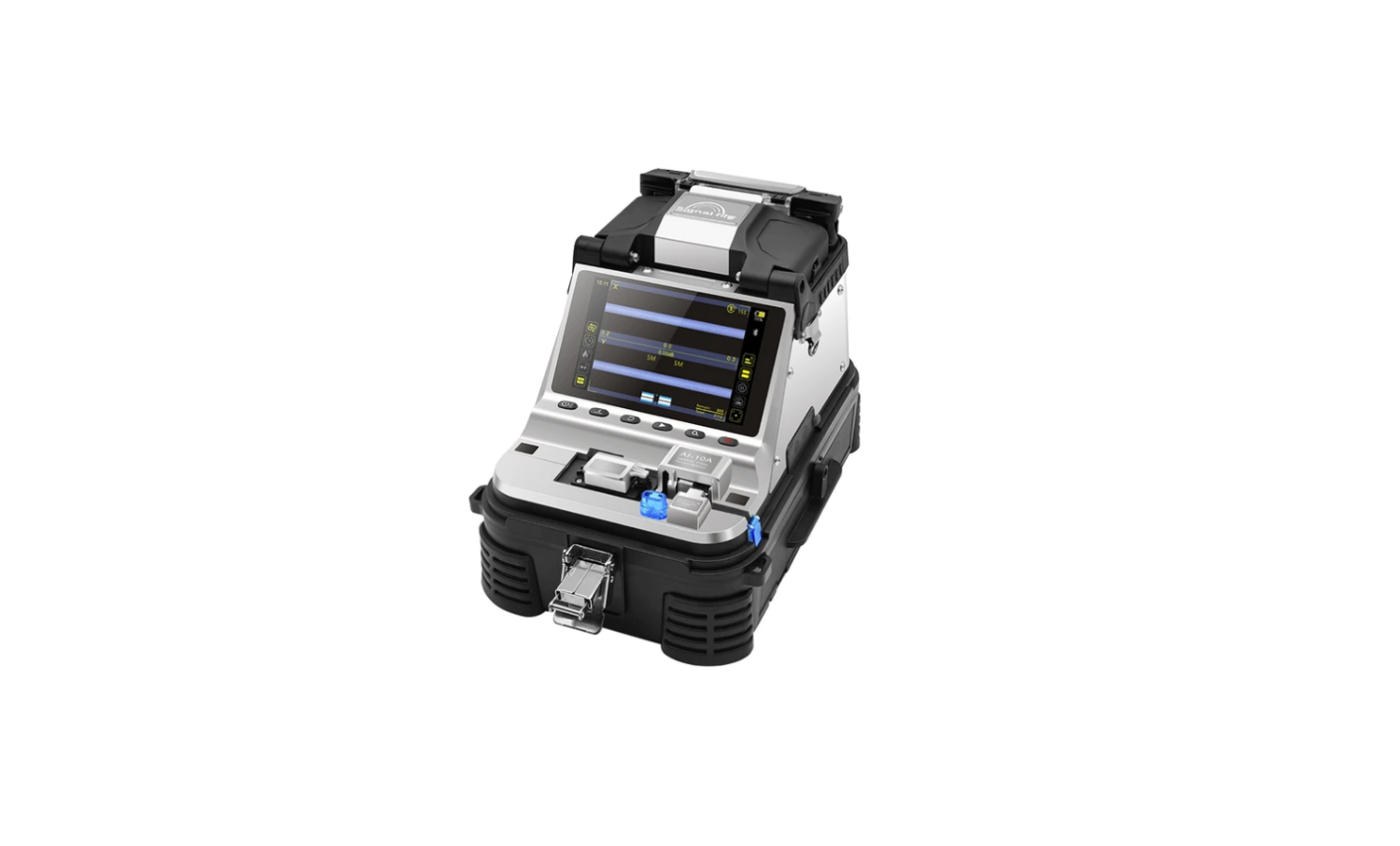
The difference between Signal fire AI-10 and AI-9 splicing machine.
Understanding the Difference Between the AI-10 and AI-9 Fiber Optic Splicing Machines
Signal Fire is a well-known brand in the fiber optic industry, specializing in high-quality fusion splicing machines and accessories. Signal Fire splicing machines, such as the AI-9 and AI-10, are widely used by technicians for their reliable performance and ease of use in various fiber optic splicing applications.
Signal Fire Splicing Machines
Signal Fire’s fusion splicing machines are designed to help technicians achieve high-precision splicing with minimal splice loss. The machines are commonly used for both single-mode and multi-mode fiber splicing, and they are appreciated for their portability, durability, and user-friendly interfaces.
In the world of fiber optic technology, splicing machines play a critical role in ensuring high-quality connections for data transmission. The AI-10 and AI-9 splicing machines are two popular models used by technicians and engineers to join fiber optic cables efficiently and with minimal loss. However, while both are designed to perform the same fundamental task, they have distinct differences that can impact their suitability for different users and projects.
In this blog, we will break down the key differences between the AI-10 and AI-9 splicing machines to help you determine which one is the best fit for your needs.
1. Performance and Splicing Capacity
The most significant difference between the AI-10 and AI-9 lies in their performance capabilities and the types of fibers they can handle.
-
AI-10: The AI-10 is a more advanced machine, often capable of splicing a wider variety of fiber types, including both single-mode and multi-mode fibers. It may also support more specialized applications, such as ribbon fiber splicing. This versatility makes the AI-10 a great choice for more complex splicing operations, especially in high-demand, large-scale installations or maintenance projects. Additionally, the AI-10's precision is generally superior, ensuring that splices are made with minimal loss and high reliability.

-
AI-9: The AI-9 is considered a more basic or entry-level splicing machine. While it is still a capable tool for single-mode and multi-mode splicing, it may not support the full range of fiber types that the AI-10 does. It’s an excellent choice for standard fiber optic installations where cost is a consideration, but it may not be suitable for advanced, specialized splicing needs like ribbon fiber splicing.

2. Splicing Time and Efficiency
When it comes to speed, both the AI-10 and AI-9 are efficient, but the AI-10 usually takes the lead.
-
AI-10: Thanks to its advanced technology, the AI-10 is designed to splice fibers faster and with greater accuracy. This can be especially valuable in scenarios where time is of the essence, such as large-scale fiber installations or network repairs. The faster the splicing process, the quicker a technician can complete the job and move on to the next task.
-
AI-9: The AI-9, while still relatively quick, is a bit slower compared to the AI-10. The splicing process may take slightly longer due to its more basic features and less advanced alignment system. This makes it well-suited for smaller jobs or installations where speed is not as critical.
3. User Interface and Ease of Use
For technicians, ease of use is a vital factor when choosing a splicing machine. A user-friendly interface can save a lot of time and frustration during fieldwork.
-
AI-10: The AI-10 typically features a more sophisticated and intuitive interface. It often comes with a touchscreen display that makes adjusting settings and monitoring the splicing process much easier. Its system allows for more fine-tuned control, giving experienced technicians the flexibility to adjust parameters for optimal performance. This feature can be particularly helpful for intricate fiber types or high-precision tasks.
-
AI-9: The AI-9 is generally simpler and more streamlined, which may be appealing to users who prefer a straightforward, no-fuss machine. While it may not have the high-tech features of the AI-10, the interface is still designed for ease of use, making it suitable for technicians who do not need the extensive control options of the higher-end model.
4. Portability and Design
Portability is an important consideration for field technicians who need to move their splicing machine between different locations.
-
AI-10: As a more advanced machine, the AI-10 tends to be slightly bulkier and heavier. While it’s still portable, it might not be as easy to carry around for technicians who need to do a lot of traveling between job sites. However, this trade-off comes with the advantage of added features and enhanced performance.
-
AI-9: The AI-9 is typically more compact and lightweight, making it a better option for those who need a portable splicing machine that they can easily transport. This is ideal for technicians working in remote locations or on smaller projects that don’t require the advanced capabilities of the AI-10.
5. Cost Considerations
Cost is always an important factor when purchasing equipment, especially for businesses or technicians working with tight budgets.
-
AI-10: As a high-end, feature-rich machine, the AI-10 comes with a higher price tag. Its enhanced performance, faster splicing time, and added versatility mean that you’ll be paying for quality and advanced technology. The investment may be well worth it if you’re regularly handling large-scale, complex fiber splicing jobs.
-
AI-9: The AI-9 is designed to be a more budget-friendly option. While it doesn’t offer all the advanced features of the AI-10, it is still highly functional and performs well for standard fiber splicing. This makes it an excellent choice for smaller businesses, technicians just starting in the industry, or anyone looking to keep costs down while still getting the job done.
Which Splicing Machine Is Right for You?
Choosing between the AI-10 and AI-9 ultimately depends on the scale of your projects, the level of precision required, and your budget.
-
If you are working on high-demand, complex splicing tasks that require top-notch performance and speed, the AI-10 is the better choice. Its advanced features, faster splicing times, and precision make it ideal for professional technicians who need the best in the field.
-
If you’re just starting out in fiber optic splicing or working on smaller, less complex projects, the AI-9 is a more affordable and still highly reliable option. It’s user-friendly, portable, and cost-effective, making it a solid choice for entry-level technicians or businesses with budget constraints.
Both machines have their merits, and with the right choice, you can ensure that your fiber optic splicing operations are efficient, high-quality, and cost-effective. The AI-10 is generally more advanced, with a faster and more precise splicing process, making it ideal for professional, high-demand environments. The AI-9 is more affordable and suitable for smaller-scale operations or those just starting with fiber optic splicing. Whether you choose the AI-10 or the AI-9, both machines are designed to improve the quality and reliability of fiber optic connections. By understanding the differences between the two, you can select the splicing machine that best suits your needs and ensures that your fiber optic installations meet industry standards.
173
0
746
172

